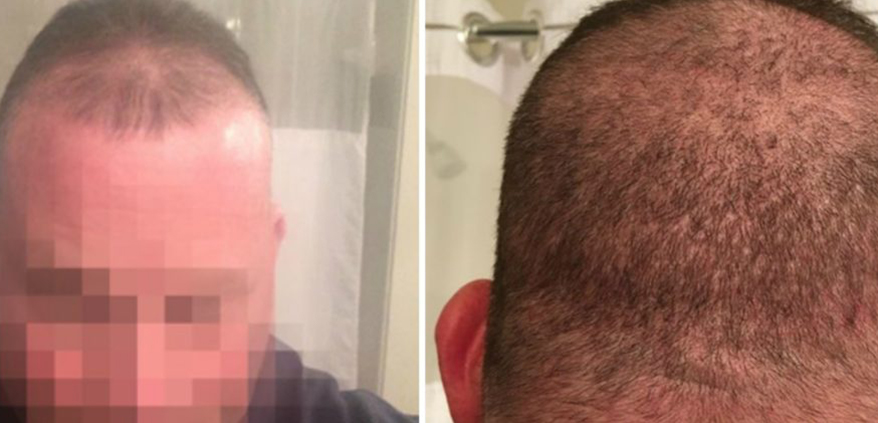“To be perfectly honest with you, I wasn’t having a mid-life crisis, so I wasn’t really looking for this.” For David D., it wasn’t a mid-life crisis, but mid-night tv watching that triggered the decision to have a hair transplant via Neograft® hair restoration.
With a young son who is often up at night, David occasionally finds himself channel-surfing when infomercials rule the airwaves. And aside from a small George Foreman Grill problem and a few groggy mornings, this turned out pretty well for David, because it’s where he first learned about follicular unit extraction (FUE), the newest method of hair transplant.
David had never liked the look of other transplant methods, so it wasn’t something he had ever considered. But this method made sense to him, and it put the idea of a transplant on his radar. Shortly after the infomercials, David started seeing billboards with some of his favorite athletes advertising FUE. That really sparked his interest, particularly when he saw the transformation in Brian Urlacher of the Chicago Bears. After extensively researching the procedure himself, David decided to take the next step.
This is when he reached out to Dr. Slack, who uses the Neograft® hair restoration system for FUE. “Dr. Slack was able to answer all of my questions and really pretty much brought everything to light before I even had a chance to ask any questions.” Dr. Slack then put David in touch with a previous Neograft® patient to answer his questions about the experience.
At this point, David knew the procedure was what he wanted, and he was convinced that Dr. Slack was the surgeon to do it. “He pretty much was the reason why I did this. I’d probably still be thinking about it if it wasn’t for just how comfortable he made the whole thing for me from the very first time I stepped foot in his office and the way he conducts himself. There was no pressure or any of that stuff.”
On the day of his procedure, Dr. Slack prescribed David a single dose of valium to help him relax. Then he had injections to numb the areas of the scalp where the procedure would be performed. David explains, “If there was any part of the procedure that had any kind of pain level to it… when he was injecting back in that area in my head, it smarted a little bit. On a scale of one to 10, it was probably a five.”
Next they cropped David’s hair a little shorter in the donor area on the back of his head. Then they went to the room where the Neograft® machine was and David got comfortable face-down on a massage-style table with his favorite music playing on his earbuds. During the extraction of the follicles from the back of his head, David says there was no pain, just some occasional pressure.
At this point they bandaged the donor area and David turned around face-up. Dr. Slack used a marker to draw the new hairline and made sure that David liked the proposed look, and then began implanting the follicles according to that guide. This part was important to David who had done so much research ahead of time, “There’s an artistry to it. This is one of the things I talked to him [Dr. Slack] about when I did my research… I think this is where, if you don’t get the right people… if you don’t get the hairs put in properly and aligned the right way… there’s a lot to it. It’s just not pulling hair out and poking a hair back in your head.”
David’s procedure went a little more quickly than expected. It started first thing in the morning and wrapped up at about 2 pm, even though they anticipated it would take the full day. Then he was bandaged up and sent home.
The recovery went more smoothly than David expected. This can be credited to the fact that he carefully followed Dr. Slack’s instructions during the days and weeks following the hair transplant. These instructions include
- keeping the bandage in place for 24 hours;
- removing the bandage after 24 hours and applying antibiotic ointment to the donor site two or three times per day for a few days;
- no rubbing, scratching, or lying on the grafted area to avoid dislodging the grafts during the first week;
- washing only after 24 hours by pouring a mixture of shampoo and water over the scalp and rinsing in the same manner – no massaging of the shampoo into the new grafts!
By day ten, David returned to work. David explains that his results are so natural, no one outside of his family even realizes he had anything done.

David on Day 1 following Neograft® hair restoration

David on Day 7 following Neograft® hair restoration
Dr. Slack points out that taking off from work is more to maintain privacy about having a hair transplant. Most patients can go back to work in two or three days if they don’t feel self-conscious about coworkers noticing they had the procedure.
Dr. Slack emphasizes that one of the giveaways that a patient has had hair restoration is that the back of the head is shaved. For this reason, he recommends patients have a close crop hair cut (with a 0 or 1 guard) a week or two ahead of time. That way people will have had a chance to get used to the new short look, and it won’t draw so much attention after the procedure.
This process is not for those looking for immediate gratification, as it will be full year before the final results are evident. The following pictures aren’t of David, but they give a sense of the typical one-year progression following Neograft hair restoration:

David is still early in the process, but now that four months have passed, he is pleased with the result. “Ask me again at the 12-month mark and I would hope to be that much more excited than I am now. My wife’s like, ‘Yeah, I can tell a big difference.’ So honestly I’m pretty excited about the results so far.”
“I would highly recommend Dr. Slack. He’s a great guy. I can just speak for myself obviously, but the whole experience was fantastic. The healing process was a lot faster than I thought it was going to be. The whole thing was just really good. I still feel great about it and I’m not even at the halfway mark.”
Are you researching your options for hair restoration? Dr. Slack would love to sit down with you and help you understand the Neograft® procedure and answer any questions you have. Just contact our office to schedule a consultation.





